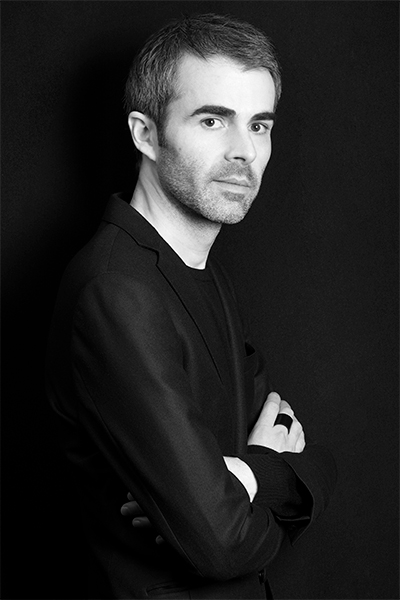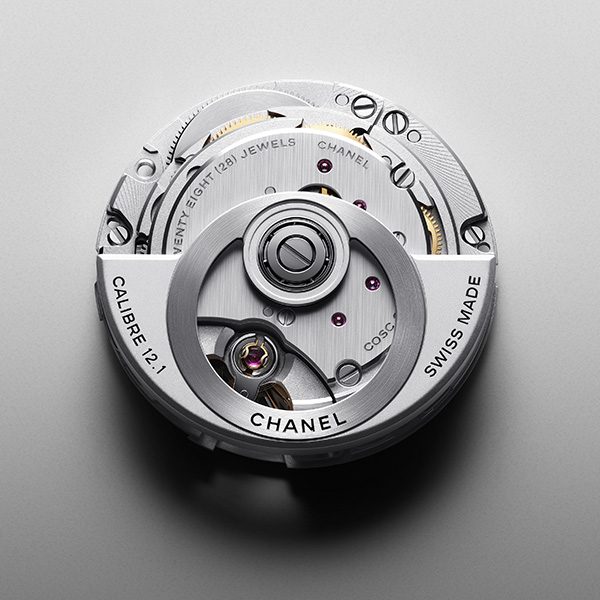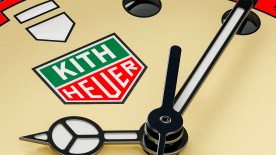When design student Arnaud Chastaingt discovered the J12 in 2000, he immediately fell in love with its “perfect silhouette, unique look and androgynous appeal.” For him, it was also a revelation about the watch as an object. In 2003, when the J12 was launched in white ceramic, his fascination grew. He describes this as a radical creative act, and one he internalised unconsciously. In the same year, after finishing his studies, he began working as a designer for Cartier where, over the next decade, he climbed the ranks. He then moved to the Maison Chanel, attracted by the company’s “atypical approach to creation, where style and design take priority over the measurement of time.” In an interview for the Baselworld 2019 issue of GMT Magazine, Nicolas Beau, director of business development for Chanel’s jewellery and watchmaking divisions, describes their decisive 2013 meeting. The first sketches Arnaud Chastaingt produced had nothing to do with the J12, however; they were for other Chanel watches: the Monsieur, the Boyfriend and the Camélia Skeleton, among others.

Change everything, or nothing
When Arnaud Chastaingt finally came face to face with the J12 in 2014, the young studio director could see only two options: “Change everything, or change nothing.” But he was torn by this paradox. He had the greatest respect for the original design by Jacques Helleu, Chanel’s former artistic director, but at the same time he refused to set the J12 aside completely. In order to put his own stamp on it, he began by taking the watch into foreign territory, changing its appearance in unusual ways, like the XS version, or putting it on a NATO strap. What about gender? “It doesn’t matter, particularly where the new generation is concerned, that women have adopted this object created basically by a man, for men. My main concern was to ensure it remained contemporary.” For a designer, not changing anything is a complex exercise, even more so than creating a completely new watch, like the Boyfriend. “So I changed everything, without changing anything, working hand in hand with everyone in the watch department. I developed a new relationship. It was almost a surgical operation, to absorb as much as I could. We carried out many tests in order to achieve that balance between the DNA and the new aesthetic. In the end, we changed 70% of the components. It’s not a new J12, it’s the J12.” [Read "All change for the J12" by Paul O'Neil for more information]

New movement, new parameters
In his role as director of the watch design studio, Arnaud Chastaingt doesn’t necessarily make the movement a priority in his initial reflections. Nevertheless, one of Chanel’s new strategic priorities is to develop its own calibres. For Nicolas Beau, “In our vision of tomorrow’s watchmaking, the watch has gone from a pure instrument to an instrument that is a beautiful object. And what goes with that is developing the movement in terms of aesthetics and durability. A wonderful design needs a wonderful movement.” And that means being able to see the movement through a sapphire case back. When this new manufacture movement turned out to be marginally bigger than the previous one, the case clearly needed tweaking too. Naturally, the design mentality was also brought to bear on this new upgraded calibre, which comes with COSC certification and a 5-year guarantee. “I didn’t want to see the traditional rotor architecture; I wanted it to be immediately identifiable, a perfectly circular opening with the baseplate showing through. Indeed, that’s one element of our haute horlogerie design charter. So we designed the rotor in tungsten. It was a huge challenge to make a tungsten rotor with such a big opening, but that’s what design is all about.” Polished and brushed finishes on the rotor complete the overall aesthetic on show through the sapphire case back.

A redesigned manufacture case
With the more generously sized movement, the caseband had to be substantially redesigned to accommodate the difference in depth. The sides are now softer, slightly convex, which gives the illusion of a more slender profile. The diameter of the crown has been reduced by a third, as has the inset cabochon, while retaining the same ergonomic characteristics. The metal ring around the bezel has also lost a third of its width, but the number of metallic ridges has increased from 30 to 40, giving it a more pronounced identity. The back of the watch is slightly domed to accommodate the shape of the movement. A new ceramic back was designed to enclose the sapphire window, and this affected the way in which the watch was assembled. Another effect of the ceramic back is that the J12 can now claim to be 100% scratch proof. Previously, the steel back was the only part that tended to show wear. The J12 is also lighter. The ceramic is manufactured internally by G&F Châtelain in La Chaux-de-Fonds, and it requires specific skills that very few watchmakers possess. For the ceramic back in particular, a number of technical limitations had to be accounted for, including the fact that ceramic shrinks by 20 to 30% when it is fired. The ceramic link bracelet has also been reworked to make it more dynamic, with longer links and a more pronounced drape.

Microscopic variations on the dial
Chanel’s progress in ceramics means that the 2019 J12 now also features ceramic numerals (up to now, only the dial itself was made of ceramic). And the numerals themselves have been updated, with a new typography in line with the codes of the Maison. As Arnaud Chastaingt explains, “If you look through a loupe, some of the lines are now more graceful, and the ceramic markers are higher quality, with flatter surfaces and sharper lines, which makes them easier to read.” Even the typeface for the date has been changed, despite the complexity involved, particularly for two-digit dates. If you have a microscope, the internal curves of the 6s and 9s are really something to see (“They exude perfection”)! At the same time, because the dial is wider, the Swiss Made label at the base of the dial now has more room between the markers and the inclined plane of the added chapter ring. The hands have also been refined: “There was a difference in their widths, and I have now made the minutes hand wider than the hour hand.” The Superluminova is more elegant and the seconds hand is more delicate. The powdery effect of the dial has been accentuated to give the piece greater coherence.

An accessible muse
But what about the price? With all these improvements, a considerable price increase would be par for the course. But in fact the price is one thing that hasn’t changed much. At just €350 more, the J12 costs just €5300. Nicolas Beau smiles: “With this J12, we’ve found the secret to eternal youth.” Arnaud Chastaingt concludes: “Today, I consider the J12 to be my muse. I’m not its father, but I’ve officially adopted it. For now, my definition of the J12 is black and white. But I’m not ruling anything out for the future.” Additional complications (chronograph, moon phases, GMT, tourbillon) are in the pipeline. We look forward to seeing something rather special in 2020, to celebrate the 20th anniversary of the J12.








